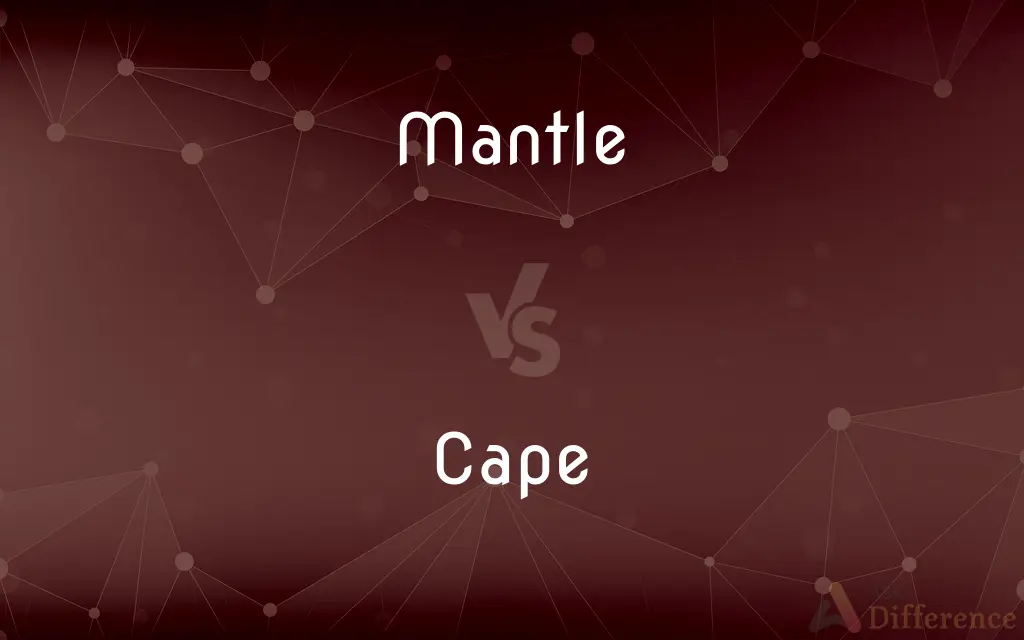Mantle vs. Cape — What's the Difference?
By Urooj Arif & Maham Liaqat — Updated on March 9, 2024
A mantle is a loose, sleeveless cloak often worn for ceremonial purposes, while a cape is a shorter outer garment used for fashion or warmth.

Difference Between Mantle and Cape
Table of Contents
ADVERTISEMENT
Key Differences
A mantle typically refers to a long, flowing garment that drapes over the shoulders and is worn as a cloak. Historically, mantles have been associated with nobility, royalty, or religious figures and often symbolize authority or a protective covering. They can be made from various materials, including luxurious fabrics, and may be adorned with intricate designs or symbols. Capes, on the other hand, are generally shorter than mantles and are worn for fashion, warmth, or as part of a uniform. They cover the back, shoulders, and sometimes the arms, and can range from casual to formal in style.
Mantles often serve a more symbolic or ceremonial purpose, used in contexts like academic regalia, religious ceremonies, or as part of traditional regal attire. They can signify status, rank, or a specific role within a group or organization. Capes, whereas, are more commonly integrated into everyday fashion and can be seen in various settings, from casual outerwear to elegant evening attire. They're versatile and can be styled in numerous ways.
The design of a mantle is usually more elaborate, reflecting its ceremonial use, with possible features like embroidery, fur trim, or elaborate clasps. Capes can also have decorative elements but are often designed for practicality and ease of movement, making them suitable for everyday wear. Some capes also include slits or openings for the arms.
In terms of historical and cultural significance, mantles have a rich history and are often seen in ancient depictions of leaders and deities, symbolizing power and protection. Capes have been popular in various forms throughout history, from practical garments in medieval times to fashionable accessories in the Victorian era and beyond.
Both mantles and capes can be made from a variety of materials, including wool, velvet, silk, and synthetic fabrics, depending on their intended use, style, and the level of warmth or protection they provide. While mantles are more likely to be custom-made or specifically tailored for ceremonial occasions, capes are widely available in retail fashion stores and can range from affordable to high-end designer pieces.
ADVERTISEMENT
Comparison Chart
Length
Typically long, flowing to the ground
Shorter, varying lengths but generally above the knee
Purpose
Ceremonial, symbolic
Fashion, warmth, practicality
Design
Often elaborate, with adornments
Ranges from simple to decorative, more practical
Usage
Nobility, academia, religious ceremonies
Everyday wear, formal occasions, uniforms
Material
Luxurious fabrics for ceremonial use
Various, including practical materials for everyday use
Compare with Definitions
Mantle
Long, ceremonial cloak symbolizing authority or status.
The king wore a regal mantle during the coronation.
Cape
Shorter outer garment for fashion or warmth.
She wrapped herself in a woolen cape against the cold.
Mantle
Often used in religious or academic contexts.
The priest's mantle was adorned with symbolic embroidery.
Cape
Part of various uniforms or costumes.
The superhero's cape became iconic to his character.
Mantle
Can be heavily adorned, reflecting its importance.
Her ceremonial mantle featured gold thread and precious stones.
Cape
Versatile in style, from casual to formal.
His tailored cape added an elegant touch to his evening attire.
Mantle
Represents a protective covering or layer.
The superhero's mantle not only signified his identity but also offered protection.
Cape
Designed for ease of movement and practicality.
The detective's cape allowed him to move freely while keeping warm.
Mantle
Made from luxurious materials for special occasions.
The velvet mantle was reserved for the most solemn ceremonies.
Cape
Available in a wide range of materials and prices.
Her fashionable cape was a recent find from a high-street store.
Mantle
A loose sleeveless cloak or shawl, worn especially by women
She was wrapped tightly in her mantle
Cape
A cape is a sleeveless outer garment which drapes the wearer's back, arms, and chest, and connects at the neck.
Mantle
An important role or responsibility that passes from one person to another
The second son has now assumed his father's mantle
Cape
A sleeveless cloak, typically a short one
He was wearing a flowing cape
Mantle
A fragile mesh cover fixed round a gas jet, kerosene wick, etc., to give an incandescent light when heated.
Cape
The pelt from the head and neck of an animal, for preparation as a hunting trophy
The hair on a cape for the taxidermist can spoil in warm weather
Mantle
The region of the earth's interior between the crust and the core, believed to consist of hot, dense silicate rocks (mainly peridotite)
Magmas erupted at mid-ocean ridges are derived from the upper mantle
Mantle rock
The presence of hot mantle leads to melting at the base of the lithosphere
Cape
A headland or promontory
We could see the island from the cape
Mantle
Variant spelling of mantel
Cape
(in bullfighting) taunt (the bull) by flourishing a cape
The film shows a man expertly caping a charging bull
Mantle
Cloak or envelop
Heavy mists mantled the forested slopes
Cape
Skin the head and neck of (an animal) to prepare a hunting trophy.
Mantle
(of a bird of prey on the ground or on a perch) spread the wings and tail so as to cover captured prey
The female Goshawk is feeding while mantling with spread wings over her prey
Cape
A sleeveless outer garment fastened at the throat and worn hanging over the shoulders.
Mantle
A loose sleeveless coat worn over outer garments; a cloak.
Cape
A brightly colored cloth used in maneuvering the bull in a bullfight; a capote or muleta.
Mantle
Something that covers, envelops, or conceals:"On a summer night ... a mantle of dust hangs over the gravel roads"(John Dollard).
Cape
A point or head of land projecting into a body of water.
Mantle
The role or appearance of an authoritative or important person:"a Carlylean conviction that in modern society a poet was obligated to assume the mantle of a prophet"(Richard D. Altick).
Cape
To maneuver (the bull) by means of a cape in a bullfight.
Mantle
Variant ofmantel.
Cape
(geography) A piece or point of land, extending beyond the adjacent coast into a sea or lake; a promontory; a headland.
Mantle
The outer covering of a wall.
Cape
A sleeveless garment or part of a garment, hanging from the neck over the back, arms, and shoulders.
Mantle
A zone of hot gases around a flame.
Cape
(slang) A superhero.
Mantle
A device in gas lamps consisting of a sheath of threads that gives off brilliant illumination when heated by the flame.
Cape
To incite or attract (a bull) to charge a certain direction, by waving a cape.
Mantle
(Anatomy)The cerebral cortex.
Cape
(nautical) To head or point; to keep a course.
The ship capes southwest by south.
Mantle
(Geology)The zone of the earth between the crust and the core.
Cape
To skin an animal, particularly a deer.
Mantle
The outer wall and casing of a blast furnace above the hearth.
Cape
To defend or praise, especially that which is unworthy.
Mantle
The shoulder feathers, upper back, and sometimes the wings of a bird when differently colored from the rest of the body.
Cape
(obsolete) To look for, search after.
Mantle
A fold or pair of folds of the body wall that covers the internal organs and typically secretes the substance that forms the shell in mollusks and brachiopods.
Cape
To gaze or stare.
The captain just caped mindlessly into the distance as his ship was hit by volley after volley.
Mantle
The soft outer wall lining the shell of a tunicate or barnacle.
Cape
A piece or point of land, extending beyond the adjacent coast into the sea or a lake; a promontory; a headland.
Mantle
To cover with a mantle.
Cape
A sleeveless garment or part of a garment, hanging from the neck over the back, arms, and shoulders, but not reaching below the hips. See Cloak.
Mantle
To cover with something that acts like a mantle; cover, envelop, or conceal:"when the land was mantled in forest and prowled by lions, leopards, and wolves"(David Campbell).
Cape
To head or point; to keep a course; as, the ship capes southwest by south.
Mantle
To spread or become extended over a surface.
Cape
To gape.
Mantle
To become covered with a coating, as scum or froth on the surface of a liquid.
Cape
A strip of land projecting into a body of water
Mantle
To blush:cheeks mantling with embarrassment.
Cape
A sleeveless garment like a cloak but shorter
Mantle
A piece of clothing somewhat like an open robe or cloak, especially that worn by Orthodox bishops. Compare mantum.
Mantle
(figuratively) A figurative garment representing authority or status, capable of affording protection.
At the meeting, she finally assumed the mantle of leadership of the party.
The movement strove to put women under the protective mantle of civil rights laws.
Mantle
(figuratively) Anything that covers or conceals something else; a cloak.
Mantle
(malacology) The body wall of a mollusc, from which the shell is secreted.
Mantle
(ornithology) The back of a bird together with the folded wings.
Mantle
The zone of hot gases around a flame.
Mantle
A gauzy fabric impregnated with metal nitrates, used in some kinds of gas and oil lamps and lanterns, which forms a rigid but fragile mesh of metal oxides when heated during initial use and then produces white light from the heat of the flame below it. So called because it is hung above the lamp's flame like a mantel.
Mantle
The outer wall and casing of a blast furnace, above the hearth.
Mantle
A penstock for a water wheel.
Mantle
(anatomy) The cerebral cortex.
Mantle
(geology) The layer between the Earth's core and crust.
Mantle
A fireplace shelf; mantel
Mantle
(heraldry) A mantling.
Mantle
(transitive) To cover or conceal (something); to cloak; to disguise.
Mantle
(intransitive) To become covered or concealed. en
Mantle
To climb over or onto something.
Mantle
(falconry) The action of stretching out the wings to hide food.
Mantle
(falconry) The action of stretching a wing and the same side leg out to one side of the body.
Mantle
A loose garment to be worn over other garments; an enveloping robe; a cloak.
[The] children are clothed with mantles of satin.
The green mantle of the standing pool.
Now Nature hangs her mantle greenOn every blooming tree.
Mantle
Same as Mantling.
Mantle
The external fold, or folds, of the soft, exterior membrane of the body of a mollusk. It usually forms a cavity inclosing the gills. See Illusts. of Buccinum, and Byssus.
Mantle
A mantel. See Mantel.
Mantle
The outer wall and casing of a blast furnace, above the hearth.
Mantle
A penstock for a water wheel.
Mantle
The highly viscous shell of hot semisolid rock, about 1800 miles thick, lying under the crust of the Earth and above the core. Also, by analogy, a similar shell on any other planet.
Mantle
To cover or envelop, as with a mantle; to cloak; to hide; to disguise.
Mantle
To unfold and spread out the wings, like a mantle; - said of hawks. Also used figuratively.
Ne is there hawk which mantleth on her perch.
Or tend his sparhawk mantling in her mew.
My frail fancy fed with full delight.Doth bathe in bliss, and mantleth most at ease.
Mantle
To spread out; - said of wings.
The swan, with arched neckBetween her white wings mantling proudly, rows.
Mantle
To gather, assume, or take on, a covering, as froth, scum, etc.
There is a sort of men whose visagesDo cream and mantle like a standing pond.
Nor bowl of wassail mantle warm.
Mantle
The cloak as a symbol of authority;
Place the mantle of authority on younger shoulders
Mantle
United States baseball player (1931-1997)
Mantle
The layer of the earth between the crust and the core
Mantle
Anything that covers;
There was a blanket of snow
Mantle
(zoology) a protective layer of epidermis in mollusks or brachiopods that secretes a substance forming the shell
Mantle
Shelf that projects from wall above fireplace;
In England they call a mantel a chimneypiece
Mantle
Hanging cloth used as a blind (especially for a window)
Mantle
A sleeveless garment like a cloak but shorter
Mantle
Spread over a surface, like a mantle
Mantle
Cover like a mantle;
The ivy mantles the building
Common Curiosities
Can mantles be worn in everyday settings?
Traditionally, mantles are more ceremonial and not commonly worn in everyday settings, unlike capes.
Do mantles have any functional purpose?
While mantles can offer some warmth or protection, they are primarily symbolic or ceremonial rather than functional.
Are all capes short and without sleeves?
Most capes are shorter and sleeveless, but there are variations with slits for arms, and lengths can vary.
How do I choose between a mantle and a cape for an outfit?
The choice depends on the occasion; capes are more versatile for everyday wear, while mantles are suited for formal or ceremonial events.
Are capes still in fashion?
Capes have seen a resurgence in fashion, with many designers incorporating them into modern attire for their elegance and versatility.
What's the significance of a mantle in academic regalia?
In academic regalia, a mantle can signify scholarly achievements, institutional affiliation, or rank.
How should a ceremonial mantle be cared for?
Ceremonial mantles, especially those made from luxurious fabrics, should be professionally cleaned and stored properly to preserve their quality.
Can a cape be suitable for formal occasions?
Absolutely, especially elegant designs made from luxurious fabrics like silk or velvet, which can complement formal attire.
Can capes be part of a professional wardrobe?
Yes, capes can be styled for professional settings, especially more tailored and subdued designs.
Is there a cultural significance to mantles in history?
Yes, mantles have been symbols of power, authority, and divinity in various cultures throughout history.
Share Your Discovery

Previous Comparison
Submit vs. Confirm
Next Comparison
Accommodating vs. AccommodativeAuthor Spotlight
Written by
Urooj ArifUrooj is a skilled content writer at Ask Difference, known for her exceptional ability to simplify complex topics into engaging and informative content. With a passion for research and a flair for clear, concise writing, she consistently delivers articles that resonate with our diverse audience.
Co-written by
Maham Liaqat













































